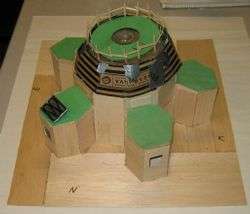Students' yurt-style design embraced by Pinoleville Pomo Nation

What started as a six-week project for engineering freshmen is helping to create culturally sensitive and energy-efficient housing for a small California Indian tribe.
A yurt-style house design conceived in last spring's E10, Engineering Design and Analysis, was used as the base concept for several successful housing grant applications by members of the Pinoleville Pomo Nation (PPN), who will use the funds to build up to 26 new homes in the Mendocino County community of Ukiah, California.
"There's an acute need for housing here," says David Edmunds, environmental director for the tribe, which has about 300 members scattered throughout northern California. "Housing is considered a linchpin for a lot of things the tribe wants to accomplish."
Sustainability is also important to tribal members, and this spring new teams of E10 students are investigating the possibility of retrofitting existing Pomo homes with solar hot water heaters, photovoltaic systems and other energy-efficient improvements.
The collaboration started last year when Edmunds and tribal representative Linda Noel approached a Native American student group at UC Berkeley for help. Their request found its way to mechanical engineering professor Alice Agogino, who teaches an E10 section on human-centered and sustainable design.
Her students, co-advised by graduate student instructor Ryan Shelby, eagerly accepted the challenge. They made the 115-mile trip to Ukiah for a day-long fact-finding meeting with 20 tribe members to solicit input on the community's needs. That kind of exchange is precisely the idea behind human-centered design, Agogino says. "Tribal members know more about their needs than we do."
The new design features a large communal kitchen and living room to accommodate extended families and tribal gatherings, with five small attached units that can be used for bedrooms and storage. The first home, now under construction, incorporates sustainable features like rainwater capture systems, passive heating and cooling systems and plenty of natural lighting.
"It resembles our traditional roundhouse," says tribal Vice Chair Angela James, "and would strengthen our community, not only economically, but traditionally." Centralized housing, the tribe hopes, will unify the Pinoleville Pomo and help members take advantage of job training and other services. Sponsoring the overall effort is CARES (Community Assessment of Renewable Energy and Sustainability), a student-run community outreach program.
"It's a real-world project that is going to directly impact the lives of people," says Shelby, a third-year Alfred P. Sloan Ph.D. student in mechanical engineering and CARES cofounder. Along with supervising the students, Shelby is incorporating the work into his doctoral research on sustainability and alternative energy.
Provided by University of California - Berkeley


















